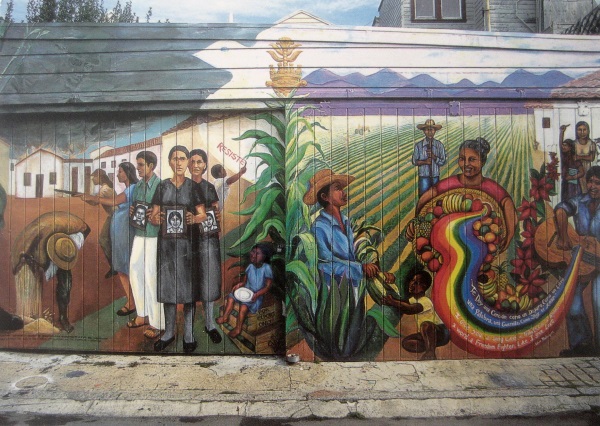A new study, published in American Psychologist, examines the origins, effects, and healing mechanisms of ethno-racial trauma on Latinx (a gender-neutral alternative to Latino or Latina) individuals, families, and communities. Drawing on intersectional theory, trauma-informed care, and liberation psychology, the researchers discuss oppressive immigration policies and explore potential healing interventions. The researchers call on the psychological community to make the field a “sanctuary discipline” and promote a four-part intervention known as HEART, “Healing Ethno and Racial Trauma.”
“The main objective of each phase is for Latinx immigrants to find relief, gain awareness, and cope with systemic oppression while encouraging resistance and protection from the external forces that cause ethno-racial trauma,” the researchers write. “Overall, our intention and hopeful expectation is that the content presented in this article serves as a call to action for psychologists to make psychology a Sanctuary Discipline by using and integrating intersectionality theory, trauma-informed care, and Liberation Psychology into policy, research, and practice with Latinx immigrants.”

The researchers, led by Nayeli Y. Chavez-Dueñas from the Chicago School of Professional Psychology, define ethno-racial trauma as “the individual and collective psychological distress and fear of danger that results from experiencing or witnessing discrimination, threats of harm, violence, and intimidation directed at ethno-racial minority groups.” The effects of violence, racism, and ethnic oppression heighten the risk of “experiencing psychological harm, including trauma.” Prior studies indicate that trauma reactions from racism or ethno-violence can be as psychologically debilitating as trauma reactions from natural disasters.
Chavez-Dueñas and colleagues outline the ramifications of nativism, racism, and ethnocentrism, initially delineating the ideals maintained by these –isms. Nativist ideologies maintain cultural stereotypes about Latinx people, “including perceptions that they: (a) are immigrants who refuse to assimilate, (b) make little effort to learn English, (c) bring with them their inferior cultural values and practices, (d) contribute to budget deficits and higher taxes, (e) take jobs away, (f) abuse public social services, and (g) reside in the country without authorization.”
Whereas racism is used to “justify harmful practices of inequity based on the belief that one race is superior to another based on skin color and phenotype.” While just a small number of studies evaluates the effects of skin color differences among Latinx people, they suggest, “being darker and having less European-phenotypic features can negatively impact mental health, educational attainment, and income.”
These commonly held stereotypes combined with racism contribute to a culture of “Crimmigration,” the criminalization of immigrants. Between 2005 and 2015, anti-immigrant legislative acts increased by 500%, from 38 to 222. In 2016, then-Presidential Candidate Donald Trump campaigned on promises to build a wall between the US and Mexico, increase ICE officials, and implement more aggressive enforcement of immigration policing. Twenty-two thousand immigrants were arrested during Trump’s first two months as president, a 32% increase from that same period the year prior.
For immigrants, exposure to traumatic events that may have led to their decision to leave their home, as well as the often traumatic journey, can cause psychological distress, which is then exacerbated by the racism, ethnocentrism, and nativism they may be face upon entering the United States. Chavez-Dueñas, Adames, Perez-Chavez, and Salas, detail the impact on individuals, families, and the larger community. The detail a culture of “crimmigration” through a case-study in Lowell, Massachusetts, that led people to: “(a) live in fear, (b) be more vigilant, and (c) have difficulties carrying on with everyday activities.”
“Given the unique ways in which Latinx immigrants are impacted by interlocking systems of oppression, healing from ethno-racial trauma requires them to have a sense of control over their own liberation,” the researchers write.
“HEART,” they write, “is designed to take place in spaces where ethno-racial minorities can feel heard, affirmed, and protected from external invalidation, threats, and hate that often contributes to psychological distress.”
The four phases that make up the HEART framework can be applied within the context of a sanctuary space, namely, where Latinx people are allowed to “(a) authentically express themselves, be affirmed, and acknowledged; (b) reprocess and mourn the losses associated with ethno-racial trauma; (c) integrate experiences of ethno-racial trauma and connect to cultural elements and practices that heal; and (d) create strategies for protecting, liberating, resisting, and organizing for social action.”
The authors describe the intention behind each phase and offer suggestions for providers/organizations to help navigate the four phases.
Phase I: Establishing Sanctuary Spaces for Latinxs Experiencing Ethno-Racial Trauma
Providers can create a sense of physical and emotional safety through respect, validation, and affirmation with a focus on “assisting individuals, families, and communities gain immediate relief from the effects of psychological distress caused by ethno-racial trauma.”
Phase II: Acknowledge, Reprocess, and Cope with Symptoms of Ethno-Racial Trauma
“Phase II aims to help clients to (a) acknowledge the impact of ethno-racial trauma, (b) process the experience in a sanctuary space, (c) develop culturally responsive ways of coping, and (d) contextualize their distress by challenging assumptions about the source(s) of their difficulties.”
Phase III: Strengthen and Connect Individuals, Families, and Communities to Survival Strategies and Cultural Traditions That Heal
This phase focuses on “assisting Latinxs to strengthen their connection with their culture, or build a connection if one does not exist.”
Phase IV: Liberation and Resistance
This phase promotes a social justice orientation for Latinx immigrants, encouraging collective social action, under the premise that “healing takes place when people (a) gain awareness of the systemic roots of the challenges, and (b) learn strategies to act in ways that resist oppression and lead to social change.”
Ultimately, the authors underscored the repercussions of oppressive immigration policies and provided a healing framework for working with the effects of ethno-racial trauma. Chavez-Dueñas and colleagues acknowledge the need for more psychological research with immigrant communities and collaboration across disciplines to test the effectiveness of the HEART framework, as well as other models. Concluding with a message for social action within the academic community, they write:
“We encourage scholars to integrate a sanctuary research framework whereby the voices, wishes, and expert opinions of the people who have survived and resisted dehumanizing and aggressive immigration policies are intricately woven into all phases of research.”
****
Chavez-Dueñas, N. Y., Adames, H. Y., Perez-Chavez, J. G., & Salas, S. P. (2019). Healing ethno-racial trauma in Latinx immigrant communities: Cultivating hope, resistance, and action. American Psychologist, 74(1), 49-62. http://dx.doi.org/10.1037/amp0000289 (Link)















I would hope that we all could help heal
trauma without making money doing it…
I believe in FREE love so to speak..
Report comment
Removed for moderation.
Report comment
People of Color have ZERO reason to trust the American medical system, including the psychology/psychiatry industry until the APA gets out of bed with covert government agencies.
Email Reveals American Psychological Association’s Role In CIA Torture:
https://slate.com/news-and-politics/2015/05/american-psychological-association-cia-torture-collaboration-documented.html
APA.org Undergraduate Internship Program at the CIA:
https://www.apa.org/about/awards/cia-ugradint
Drugs Used As Weapons Against Us:
https://www.drugsasweaponsmovie.com
MKUltra anyone?
https://www.history.com/mkultra-operation-midnight-climax-cia-lsd-experiments
Report comment
Removed for moderation.
Report comment
I don’t know what you’re talking about. I didn’t report your comment and I don’t have the ability to remove comments.
I don’t entirely disagree with you, though I think you could make a better case for your position than calling people crazy. Perhaps that was what got your first comment removed.
I don’t appreciate being targeted like this. If I have a problem with something you say, I have the cajones to say so directly to you myself. Your paranoia is unbecoming.
Report comment
His comment was removed by MiA because it discussed the APAs GLBTUVWXYZ M K Ultra brainwashing of our society. Satanic societal brainwashing which will be very profitable for the APAs in the long run.
Report comment
I don’t get the sense that Cat’s comments were directed at you specifically, I think he was being careless with the placement of his remarks. But he should be more careful about this, especially with emotionally-laden stuff.
Report comment
It doesn’t matter who it was directed at. The_cat has a history of promoting vigilante justice and making threatening statements toward anyone here, telling them they “better stop”, is unacceptable.
I would be happy to debate the concept of rapidly changing gender identity norms, but not when the people involved are targeted as crazies and the children involved slandered as “theybies”. That’s not a genuine attempt at dialogue, and I have no problem with it being removed.
Report comment
Not even touching the subject matter here, just surmising that Cat was probably not angry at you personally but at Steve. But like I said he should be more careful rather than taking a scattershot approach towards anyone who is in the way.
Report comment
If Steve commented, I didn’t see it before he removed it, so I’m going only on what I’ve seen. (This is a good reason not to remove moderated comments entirely, and why a placeholder “this comment is awaiting moderation” is helpful to follow the flow of the conversation.)
Report comment
Nothing will solve these problems short of revolution. It’s just more liberalism to suggest that racism can be “healed” via schemes such as this.
Report comment
Much of the instability in Latin American countries has been a direct result of overt and covert interventionist policies and exercises of the US Government. There would not be an influx of immigrants on our southern border if not for the covert operations of the CIA, and propaganda campaigns carried out by US Government supported NGOs. To suggest that refugees and immigrants aught to embrace an industry that is in bed with the federal intelligence agencies is to suggest that these immigrants don’t understand the issues going on in their countries and serves to further the manufactured consent that the media elicits with stories like these, dressed up as providing “help” and pontificating on how to get an oppressed people to accept further oppressive “help”.
Report comment
Most white people just don’t get it.
Chavez-Dueñas and colleagues acknowledge the need for more psychological research with immigrant communities and collaboration across disciplines to test the effectiveness of the HEART framework, as well as other models.
More “research,” right. Just like some think that we need to continually “rethink” psychiatry and do more “research” on neurotoxins. And trivialize the matter as something that can be resolved with academic “models,” as opposed to revolutionary political action. “Social justice” is a liberal code word these days, and has little to do with actual justice.
Report comment
Completely agreed. What better group of people to study your interventions on than the ridiculously disempowered?
Report comment
Removed for moderation.
Report comment
Don’t forget that the schools, APAs, and our government are brainwashing our children, in both the public and private schools, with this LGBTUVWXZ … psychological/psychiatric MK Ultra brainwashing.
Trust me I know, a psychologist and psychiatrists profiteered off of covering up the rape of my child, by trying to murder me via 14 different anticholinergic toxidrome poisonings. Then attempted to drug my child, once the medical evidence of the abuse of my child was handed over.
These child rape covering up hobbies of the psychological and psychiatric industries, and their defamation and attempted murders of me, have resulted in me now having one gay child and one trans child. Children brainwashed by their schools and the APAs GLBTUVWXYZ theologies being infiltrated into those schools.
Why? Because brainwashing children into becoming transexual is proven to increase the likelihood of suicide enormously, which is really profitable for the psychologists and psychiatrists. God damn the APAs for their MK Ultra brainwashing of our society, and our children in their schools.
Please create a clean heart in me, oh Lord, and in my children and in all the decent and innocent Americans, my God. Who have been MK Ultra’ed by the satanic, child rape covering up and brainwashing, psychological and psychiatric industries.
Report comment
So, being victim to racism is the new disease? Huh?
So one day, in my neighborhood, my friends informed me about Santa Claus. We were barely out of toddlerhood. I went back and asked my mom about that. She explained that we do not have Santa because we were Jews.
Was I suffering from Santa deficiency? What is the therapy for that? Is the world of psych, psychology and psychiatry arm in arm, insistent that they’re the ones to go saving everyone, now going to make me role-play with a stuffed Rudolf?
Why should being who I am, including my heritage, be a disorder? This type of therapy seems to reinforce this, encouraging minorities to go right down the rabbit hole.
Report comment